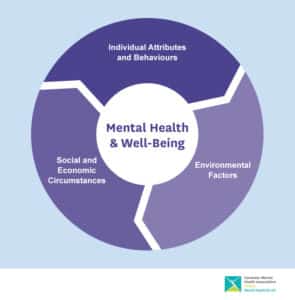
Mental health and mental illness are not static; they change over time depending on many factors. According to the World Health Organization, mental or psychological well-being is influenced not only by individual characteristics or attributes, but also by the socio-economic circumstances and the broader environment we live in.

Individual attributes and behaviours
These make up a person’s “emotional intelligence” – our awareness of our own emotions and our ability to evaluate and regulate the way we think and feel in daily life and the way we deal with the social world around us. Individual factors also create our “social intelligence” – how we interact and negotiate complex social relationships; how we understand, interpret and respond to other people’s emotions; and how we respect different points of view.
Additionally, personal genetic and biological factors can influence our mental health; for example, chromosomal abnormalities (such as Down syndrome), chemical imbalances in the brain, and damage to the brain from infections, trauma at birth or prenatal exposure to alcohol.
Socio-economic determinants
A person’s physical and mental health is shaped to a great extent by social surroundings and economic conditions and circumstances. The better these conditions are, the lower the risk for mental disorders. According to the Canadian Mental Health Association, when it comes to mental health, three social determinants are particularly significant: freedom from discrimination and violence, social inclusion and access to economic resources.
Environmental factors
Environmental factors have been shown to contribute to or cause mental health problems. For example, certain stressors in life, such as the death of a loved one, a dysfunctional family life, substance misuse, or life changes such as a divorce of loss of a job can contribute to poor mental health. Other things that can have significant mental health consequences include access to the basic necessities of life – and the cultural or social expectations surrounding these necessities; the presence of pollutants, viruses or toxins; certain geographical locations; and national and global social and economic policies.
All of these complex and often intersecting elements need to be considered in perspective because mental disorders tend to result from combinations of all or many of these factors.
All articles and other information posted on http://teacherslife.com are intended to be informational only and not for the purpose of providing any health, medical, financial, insurance, legal, accounting, tax or other advice. Teachers Life does not guarantee or represent that any information in these articles or elsewhere on this website is accurate, complete, current or suitable for any particular purpose. You use or rely on such information solely at your own risk. All articles and website content are the property of Teachers Life and all rights are reserved. IN NO EVENT WILL TEACHERS LIFE BE LIABLE FOR ANY LOSS OR DAMAGE YOU INCUR RELATED TO YOUR USE OR RELIANCE OF THE INFORMATION IN THESE ARTICLES OR ELSEWHERE ON THE WEBSITE. See the Terms of Use for more information.

